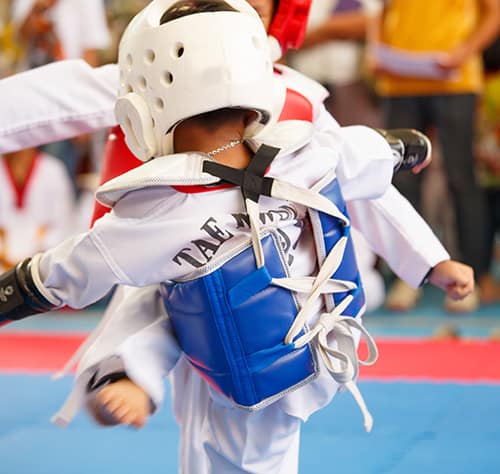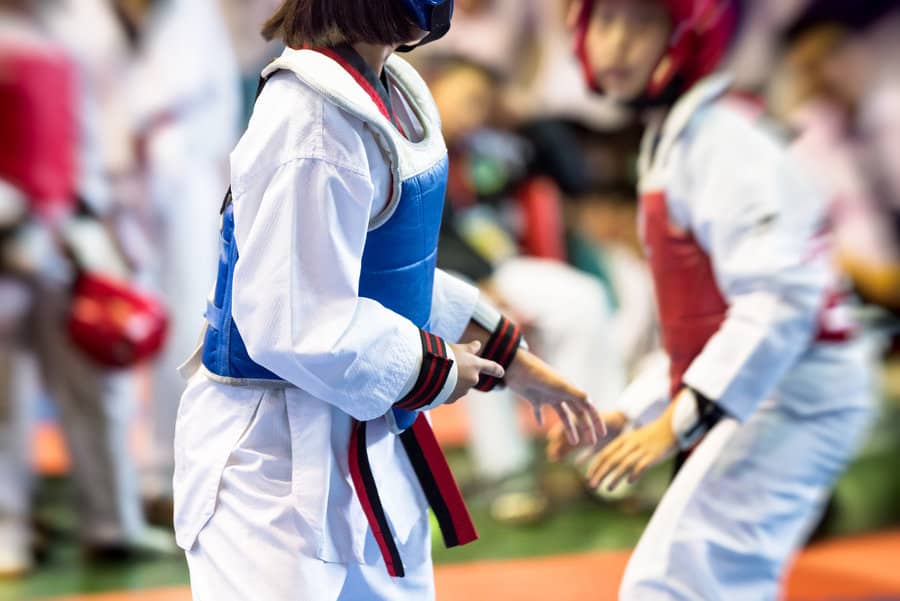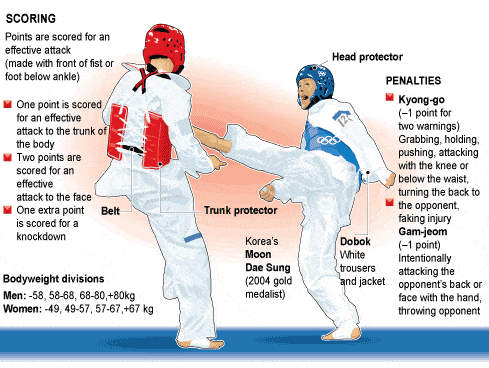
As I have mentioned on more then a few occasions, I studied TaeKwonDo when I was younger, then took a long break and then a few years ago (well maybe more then just a few!) then got back into it and have been taking it ever since.
One of the events that are always being displayed in my school is a brochure or flyer talking about an upcoming TaeKwonDo tournament either in my area or if its larger one, then in the region.
Now at this point in my life, I don’t see myself doing any tournaments but I do want to go see them not only to see how my school does in these tournaments but also maybe to learn something new about TaeKwonDo Sparring that I did not know before that maybe I could apply while sparring at the school.
However, since its been a while, I didn’t have any idea about the latest TaeKwonDo tournament rules or how the scoring was done so I decided to do a little research to find the answers before I go and this is what I found out:
TaeKwonDo Tournament Background
TaeKwonDo tournaments are not meant to replicate a real fight or show off real life fighting skills. Its all about demonstrating mastery of techniques, and the flashier and more complex the technique the better. These more “showy” techniques such as a spinning hook kick, are also, not coincidentally, the most powerful.
However to use that same kick in a street fight is probably not the best idea because, unlike in a tournament setting, if you miss with the kick or don’t execute it properly, the person you are fighting in the street is not going to wait for you to get off the ground or there is not going to be a referee holding his opponent back until you are ready to go again.
Its not my intent here to be overly dramatic , its just to make a point that at a TaeKwonDo tournament you get more points for kicks to the head since it shows, among other things, speed and flexibility.
Because of the point structure, these kicks are tried as the fighter knows that only will he score more points but also if he does the kick wrong or misses completely and ends up falling to the ground there won’t be someone on top of him to take advantage of that as would be the case in a street fight.
Other words the tournaments offer a much more controlled environment where these types of kicks can be showed off.
General Taekwondo Tournament Rules

The rules start even before the match begins. In a official tournament setting you will have to observe a couple of simple formalities so you do not get disqualified before you throw even your first kick (or punch).
This includes bowing to both your opponent and to the referee of the match who is always a black belt or higher and who is there to enforce the rules.
You must also bow to the 3 judges, again all black belts, that will decide the winner by using their best judgement and experience of strikes and the use of strikes/kicks that your should know at your level.
Of course, if your sparring in your school, it will probably be a bit more relaxed unless they are trying to get you ready for a tournament.
As far as the competition itself is concerned, each match is comprised of three rounds lasting two minutes each, with one minute breaks between each round.
The competitor that manages to score the most from these three rounds is automatically named the winner.
Scoring

Scoring in a TaeKwonDo Tournament as you can probably imagine is done primarily with kicks and the fighters aim is to land as many SCORING kicks or punches on his opponent as possible during the competition.
In order to get these points, there is, at least at the outset, a strategy planned to get the most points but from what I have seen, this strategy goes by the wayside because the match is such a fluid situation that what you thought you might do at the outset is not what you are able to do.
That being said each target area on the body will earn a different amount of points and both kicks and punches have to have force behind them in order to get a point.
In other words it cannot just be a light tap. Also kick only counts as a point if you hit with your foot so if the opponent is hit with a shin or knee you don’t get anything.
A Breakdown of Tournament Points
Hits to the Body
This gets you one point if you use say a straight turning kick or front kick. However if you hit the body with a spinning kick for example a jump back kick then you get three points. Punches which don’t carry much weight in TaeKwonDo tournaments will only get you one point. So you can see why so many kicks are thrown.
Hits to the Head
This is where the points are really made. If you kick your opponent in the head, like again a turning kick you get three points but if you show a little flare and hit the head with a spinning hook kick you’ll get an extra point so four points for that.
Knockdowns
Finally if you use a kick or punch that puts your opponent on the floor (or mat) that will get you three points.
Whats the definition of putting your opponent on floor you might ask? Its if any part of your opponent hits the floor (except of course the feet) due to your kick or punch.
Tournament Penalties
Penalties in TaeKwonDo sparring are sometimes just unavoidable. There will be times when you unintentionally do something that will cause you to get a warning from the referee and there is nothing you can do about it.
Then there are those more blatant or more purposeful penalties that someone is hit with and probably should be in order to keep the integrity and the fun in TaeKwonDo Tournaments.
Here I will go over the 2 types of penalties in a Tae Kwon Tournament and what the penalty is for the infraction.
Warning Penalties
The first penalty is called Kyong Go and is basically warning where a half point is deducted.
Examples of Kyong Go penalties are:
- Pretending to be injured
- Grabbing your opponent
- Pushing your opponent with your shoulder, body, hands or arms
- Stepping outside the boundary lines on purpose
- Attacking the groin area on purpose (Should be one point)!
Point Deduction Penalties
The second type of penalty is called a Gam Jeom and is much more serious and therefore one full point is taken away.
Examples of Gam Jeom penalties are:
- Going after an opponent when they are already on the ground
- Intentionally hitting the back of the head
- Intentionally going after the face with either the hand or fist
- Headbutting an opponent
- Violent or extreme outbursts towards either your opponent or the referee..
If you get a total of three penalty points you are automatically disqualified from the match and sent packing.
How to Win a Taekwondo Tournament

The Most Disappointing Way to Win
Withdraw
So your all psyched up ready to go and for some reason your opponent cannot compete. However it could also mean that you did well and your opponent is unwilling or incapable due to perhaps an injury of coming out for the next round
Disqualification
You opponent could not be allowed to fight because he could not make the weight class you are competing in or for some reason the officiating board will not permit the fighter to compete
Unusual Ways Of Winning a Tournament:
Referee Stops the Contest
This is often referred to as a RSC as the referee has determined that your opponent should not continue either after a knock down or after checking on the fighter in between rounds. This is done for the health and safety of the fighter.
Win by Referees Taking a Point Away
As noted above in the penalties section, if your opponent get 3 penalty points, they become disqualified and are out of the match
Common Ways of Winning a Tournament
Winning By Knock Out
Winning by knockout is a valid but unfortunate for your opponent way of winning. The referee will make the decision but when you land a blow with enough force that your opponent is staggering or unable to respond to a command or question, the bout will be stopped.
Winner by points
This is a great way to win.. Everyone walks away after both giving there all and your hard work pays off by scoring more points. At the end of the three rounds, the participant with the most number of points is declared the winner.
However, unlike other sports, a draw in points in taekwondo does not always require an additional round to determine the winner, although it is possible. A golden point round will be organized, and the first player to score a point in this round will be named the winner.
What about a Tie?
Another way of determining the winner, in case of a tie, is to take the points that each player scored before any penalty deductions were made. The player with the highest number of points wins. If this, too, is not an option, the referee will declare the player based on who has shown more willingness to attack during the game.
Note: You could also win by getting more then 12 points against your opponent. Its sometimes referred to as a 12 point gap where the spread is so big that its almost impossible for your opponent to come back from and to avoid injury the match is stopped at the end of the current round
Tournament Terminology
When you go to a tournament for the first time, you may hear alot of terms that you don’t know and that refer to equipment, the tournament setting etc.. Here is a quick guide to some of the most common terms you may hear:
Chest protector: protects the torso and marks out the scoring areas on the body during Taekwondo.
Chung: the Taekwondo contestant wearing blue.
Contest area: A10m (32 ft) square in the center of the mat where a Taekwondo contest is conducted.
Deuk-jeom: A point in a Taekwondo tournament
Dobok: Uniform worn by a Taekwondo student.
Dojang: The place where Taekwondo is practiced.
Gam-jeom: A penalty that automatically costs a contestant a point in Taekwondo.
Head guard: Worn by a Taekwondo competitor to protect the head. These will be colored either blue or red.
Hong: The Taekwondo contestant wearing red.
Referee’s mark: A point marked out on the mat where the referee begins and ends each round.
Round: One of a series of periods that make up a taekwondo match. Contests are normally three rounds long, and these rounds are separated by rest periods of usually one minute each.
Scoring area: the area of the opponent’s face or body where a legitimate strike may be made to score a point in Taekwondo.
Shi-jak: the referee’s command which starts a Taekwondo contest.
Final Thoughts
Going to either a local or national TaeKwonDo Sparring Tournament is much more exciting for me now.
Its so much more interesting to watch a match now as I understand better how the points are scored and now I can have a more educated opinion about whether I agree with the referee when he gives a point or takes one away.
At some point in the future I would like to go see an Olympic Taekwondo event at or maybe the Olympic Trials since now that I understand a lot of what is involved in winning a match.


